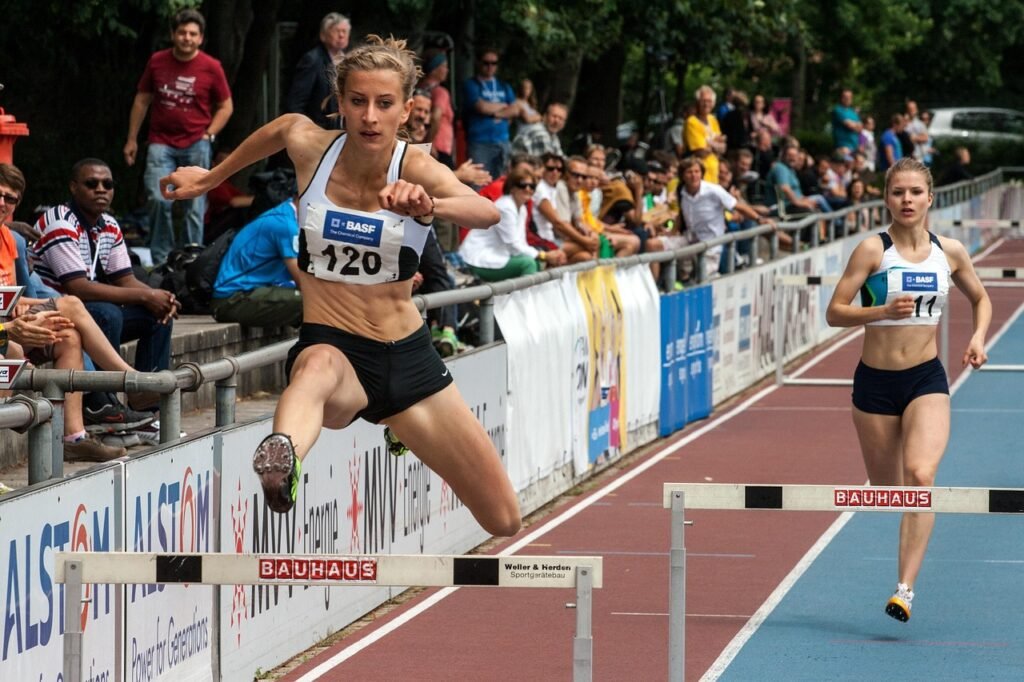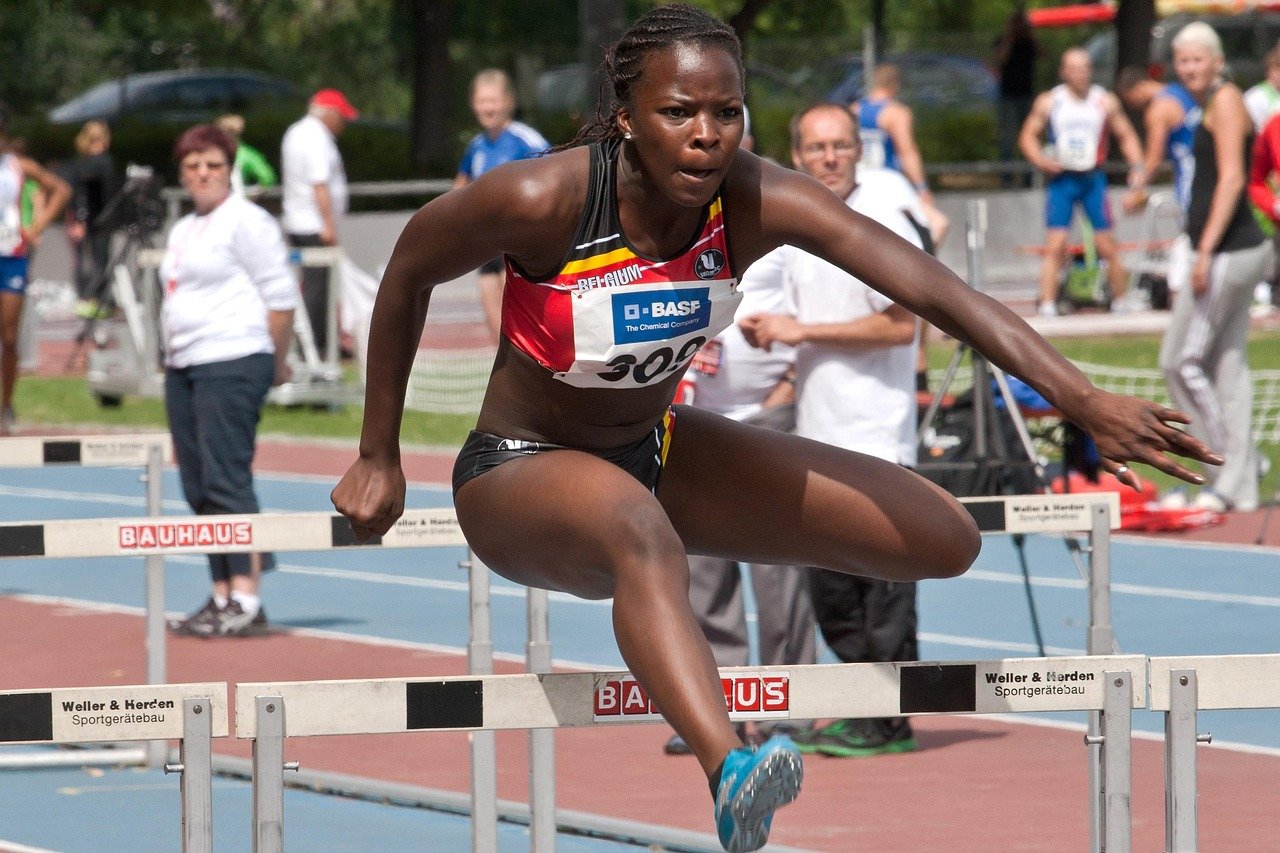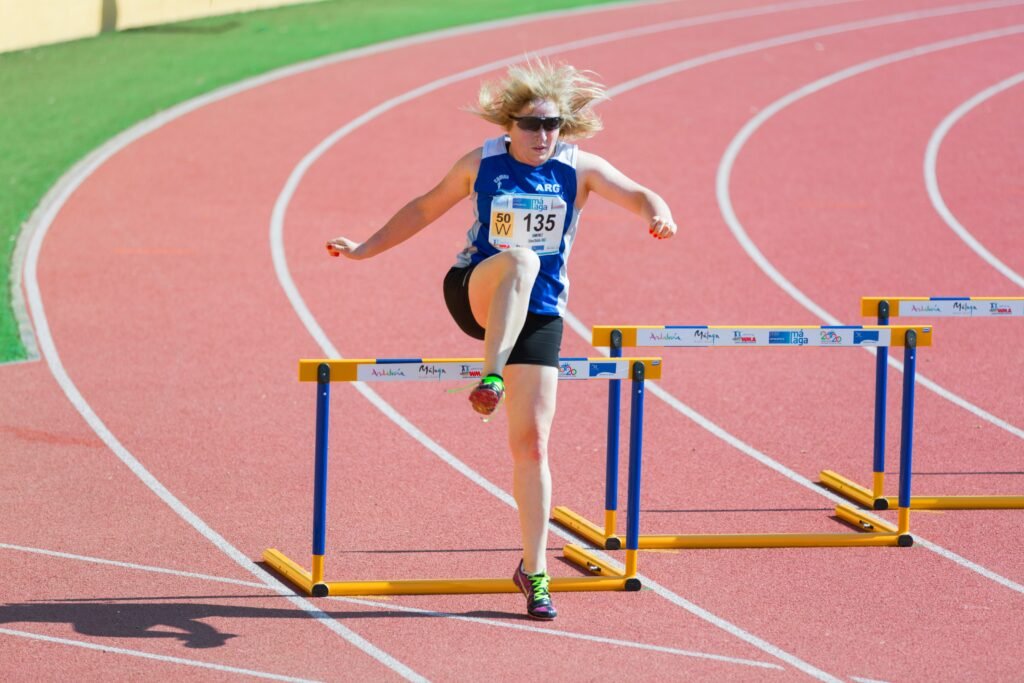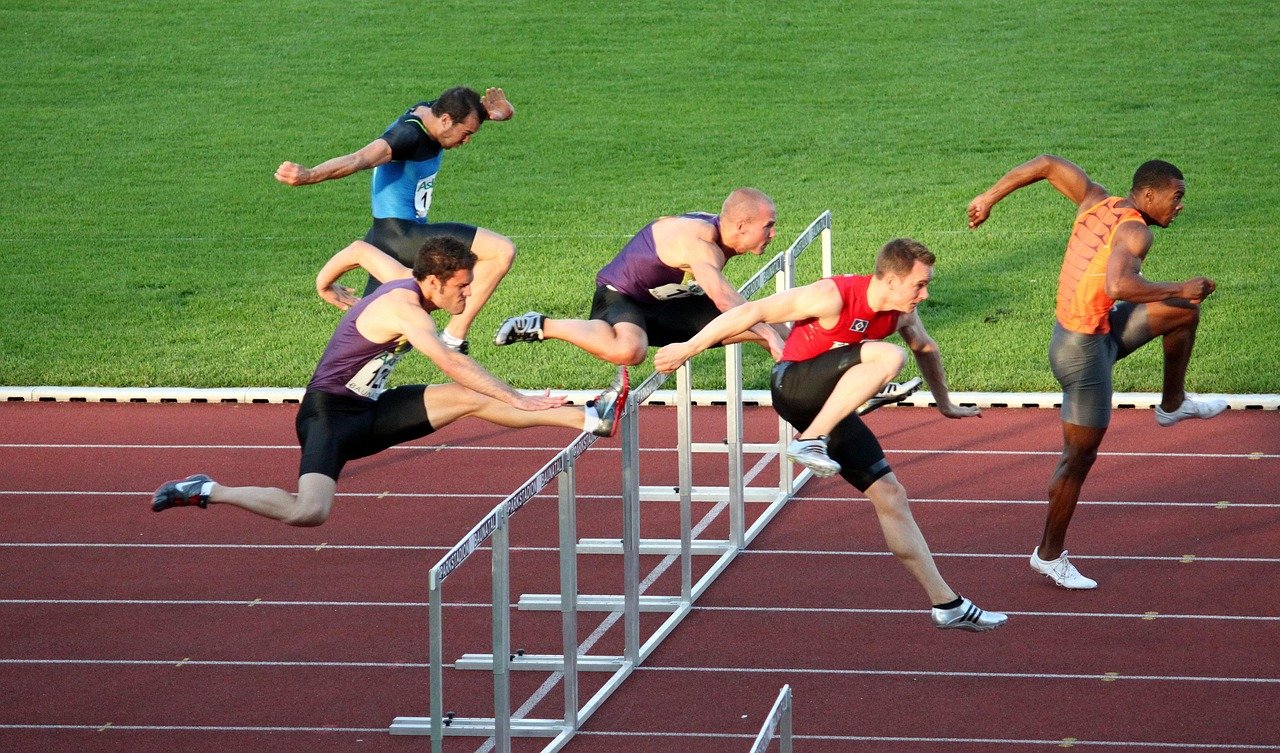Hurdle Techniques is often considered one of the most technically demanding events in track and field. It’s not just about speed but precision, rhythm, and control. Whether you’re a coach working with budding athletes or a track star looking to master your craft, teaching and learning proper hurdle techniques is crucial for success and injury prevention.
This guide covers essential hurdle techniques, performance-enhancing drills, and common mistakes to avoid, complete with practical examples and tips. Let’s jump in (pun intended!).
The Key Components of Effective Hurdling Techniques
Before exploring Hurdle techniques, we must understand that hurdling is not simply running and jumping; it’s an artful combination of sprinting, timing, and clearing obstacles smoothly. Mastering hurdling requires breaking the race down into manageable components.
1. Approach to the Hurdle
The approach sets the stage for a successful clearance. Athletes should build controlled speed and maintain consistent strides leading into the first hurdle.
Best Practices:
- Use eight strides (typical for most athletes) before the first hurdle in the 100m/110m hurdle race.
- Keep your body upright and your eyes forward. A focus on rhythm during the approach ensures smooth transitions.
Example:
Nia Ali, an Olympic hurdler, trains extensively to perfect her approach. She practices her starting strides to find the “sweet spot” that aligns her takeoff perfectly with the first hurdle.
refining her hurdle techniques for better performance.
2. Lead Leg Technique

The lead leg, or the leg that clears the hurdle first plays a pivotal role in ensuring a fast and smooth flight. It requires a quick and efficient snapping motion.
Best Practices:
- Drive the knee of your lead leg straight toward the hurdle.
- Extend the leg just before clearing the hurdle, keeping it a little bent to ensure faster transitions.
- The lead leg foot should be flexed, with toes pointed upward for clearance.
Drill for Improvement
Set up low hurdles in sequence and practice clearing them while focusing solely on the lead leg’s snap and extension. refining your hurdle techniques for better performance.
3. Trail Leg Technique
The trail leg (the one that follows the lead leg over the hurdle) is just as crucial for maintaining balance and rhythm. An improperly executed trail leg can lead to loss of momentum or disqualification.
Best Practices:
- Bring your trail leg forward with the knee pointing outward. Think of clearing the hurdle sideways with your trail leg.
- Drive the trail leg through quickly to minimize time over the hurdle.
- Keep your shoulders square to avoid twisting your upper body.
Example:
Former world champion Colin Jackson was known for his impeccable trail leg control. He focused on ensuring that his trail leg never broke his flow or disrupted his rhythm. showcasing exceptional hurdle techniques.
4. Hurdle Clearance

Hurdle clearance is the most delicate part of the process. The goal is to minimize “air time” while clearing comfortably and smoothly.
Best Practices:
- Keep your center of gravity low. Flying too high wastes time and energy.
- Lean slightly forward with your torso to reduce drag and improve forward momentum.
- Coordinate your arms; the opposite arm should balance the lead leg’s movement by driving forward naturally.
5. Post-Hurdle Sprint
When athletes land, they must be ready to sprint aggressively toward the next hurdle. Quick recovery is vital for maintaining rhythm.
Best Practices:
- Reengage your sprinting form immediately after landing.
- Focus on short, powerful strides to quickly regain speed.
- Maintain confidence and forward focus.
6. Breathing and Timing
Hurdle races are about rhythm and timing. Proper breathing can help athletes relax and stay consistent throughout the race.
Best Practices:
- Pair your breathing rhythm with hurdles. For instance, take a breath every third stride if possible.
- Stay relaxed; tension can disrupt timing and technique.
Example:
Top hurdlers often describe the 110m hurdles race as “12 distinct battles.” Breathing and rhythm help them stay calm as they face each obstacle. ensuring they execute their hurdle techniques effectively throughout the race.
7. Drills for Improving Technique

Great hurdlers are built-in training sessions. Focused drills help athletes isolate and perfect parts of their hurdling technique.
Key Drills:
- Three-Step Drill: Space hurdles closer together than usual and practice taking quick three-step intervals. This improves rhythm and sprinting technique.
- Trail Leg Drill: Set up a single hurdle and practice repetitive trail leg swings to improve flexibility and control.
- Bounding over Low Hurdles: Use lower hurdles to work on minimizing air time while maintaining good form.
Case Study:
Jasmine Camacho-Quinn, the 2021 Olympic gold medalist, refines her form by incorporating hurdle drills alongside strength training. Her repetition-based training ensures muscle memory kicks in during races.
8. Mindset and Focus
Hurdling isn’t just a physical challenge; it’s a mental one too. Maintaining focus as fatigue creeps in often separates the winners from the rest.
Best Practices:
- Visualize the race before stepping onto the track. Picture each hurdle and your movements over it.
- Compartmentalize each hurdle. Treat them as individual challenges rather than considering the entire race simultaneously.
- Build confidence through regular practice.
- Example:
Top hurdlers attribute much of their success to mental preparation, where they focus on executing their hurdle techniques with precision, even when fatigue sets in.
9. Common Mistakes and How to Correct Them

Mistakes are part of learning but can be corrected with the proper focus and training.
Common Errors and Fixes:
- Jumping Too High Over the Hurdle: Focus on controlled clearance and drive your hips forward, not upward.
- Chopping Strides Before Hurdles: Practice the three-step drill to develop confidence in maintaining stride lengths.
- Leaning Too Far Forward: Keep your torso slightly forward but aligned with your sprinting motion. Over-leaning offloads balance.
- Twisting Upper Body: Practice drills focusing on square shoulders and the correct arm motion.
10. Race Strategy
Success in a hurdles race depends on executing a well-thought-out strategy.
Key Points:
- Start Strong: Explode out of the blocks but remain controlled.
- Stay Rhythmic Mid-Race: Prioritize rhythm and timing over sprinting all-out.
- Finish Strong: Maintain consistent strides despite fatigue; focus on smooth, quick transitions.
Bringing It All Together
Mastering hurdle techniques requires dedication, practice, and patience. Breaking the race into components such as approach, clearance, and post-hurdle sprinting makes it easier for athletes to refine their skills step by step. Incorporating drills like the three-step drill and visualization practices ensures sustained improvement.
For coaches, creating structured training plans focusing on rhythm, flexibility, and technical consistency is key to developing successful hurdlers. Keep track of each athlete’s progress by addressing common mistakes individually and adding variety to maintain engagement during training sessions.
Finally, remember that hurdling is both a physical and mental game. Building confidence, focus, and mental resilience will elevate athletes to their full potential. With these techniques and strategies, you’re ready to help athletes glide smoothly over every hurdle.
(FAQs)About Hurdle Techniques
Q1 .What is the best technique for hurdles?
The best hurdle technique combines speed, form, and rhythm. Sprint towards the hurdle, drive your lead leg forward over it, keep your trail leg close and quick, lean slightly forward, and land smoothly to maintain momentum. Consistency in stride and flow is key.
Q2 .What is a hurdle method?
The hurdle method refers to the technique used for efficiently navigating hurdles during track and field events. It involves maintaining a consistent sprinting rhythm, using the lead leg to clear the hurdle, keeping the trail leg swift and tight, leaning slightly forward, and resuming stride seamlessly after landing. The goal is to minimize time spent over the hurdle while maintaining speed and flow.
Q3 .What are the three types of hurdles?
The three main types of hurdles in track and field are:
- High Hurdles: These are used in short-distance events (e.g., 100m for women, 110m for men) with higher barriers and a strong emphasis on speed and technique.
- Intermediate Hurdles: These are found in events like the 400m hurdles, which have slightly lower heights than high hurdles and require a balance of speed, endurance, and rhythm.
- Low Hurdles: These are used in training or beginner events. They are set at lower heights to focus on technique and build confidence.
Each type is tailored to specific events and skill levels!
Q04. How do I improve my trail leg motion?
- Practice wall drills and ensure a tight circular motion.
Q5 .What are the skills in hurdles?
Hurdling requires several key skills, including:
- Speed: Maintaining a fast pace to maximize momentum between hurdles.
- Agility: Quickly and efficiently clearing hurdles while minimizing time in the air.
- Flexibility: Having a range of motion in the hips and legs to achieve proper form.
- Coordination: Synchronizing arm, leg, and core movements to maintain rhythm.
- Strength: Building lower body power for explosive takeoffs and smooth landings.
- Balance: Keeping a steady and stable posture throughout the race.
These skills work together to achieve an efficient and competitive hurdling performance!
Q6 .What Are Hurdle Race Rules?
Hurdle races follow these key rules:
- Lane Adherence: Athletes must stay in their assigned lane throughout the race. Crossing into another lane may result in disqualification.
- Hurdle Clearance: Athletes must attempt to clear each hurdle. Knocking down hurdles is allowed if unintentional, but deliberately pushing them can lead to disqualification.
- Stride Pattern: While there’s no specific rule on stride count, maintaining a consistent rhythm is crucial for performance.
- Start and Finish: A false start disqualifies the runner, and the race ends when the torso crosses the finish line.
- Hurdle Sequence: All hurdles must be crossed in the correct order.
Adhering to these rules ensures fair competition and optimal performance
Q7 .How Many Types of Hurdles?
There are primarily three types of hurdles in track and field:
- High Hurdles: Used in short-distance events like the 100m (women) and 110m (men), with higher barriers.
- Intermediate Hurdles: Found in longer events such as the 400m hurdles, with slightly lower barriers.
- Low Hurdles: Common in training or beginner events, set at lower heights for technique development.
Each type caters to specific events and athlete skill levels!
Q8 .What Are Hurdles Equipment?
Hurdles equipment typically includes:
- Hurdles: Adjustable barriers designed to specific heights for various events, like 100m, 110m, or 400m hurdles.
- Starting Blocks: Used to help athletes achieve a strong and explosive start.
- Track Shoes: Lightweight, spiked shoes for grip and speed on the track.
- Markers: Used for setting up hurdles at correct intervals based on the event.
- Training Aids: Items like cones, mini-hurdles, or resistance bands for drills and practice.
These tools are essential for both training and competition in hurdling!
Q9. What is The best Hurdle height?
The best hurdle height depends on the event and the athlete’s skill level:
- Men’s High Hurdles: Typically set at 42 inches (106.7 cm) for 110m hurdles.
- Women’s High Hurdles: Generally 33 inches (83.8 cm) for 100m hurdles.
- Intermediate Hurdles: Commonly set at 36 inches (91.4 cm) for 400m hurdles.
- Training Hurdles: Can be adjusted to lower heights for beginners or specific drills.
The “best” height is the standard for the event or training purpose, ensuring optimal performance and safety
Q10. How to Train for hurdles at home?
Training for hurdles at home can focus on improving speed, technique, and flexibility without requiring a full track setup. Here’s how:
- Speed Work: Perform sprints in your backyard or a clear space to enhance your acceleration and rhythm.
- Flexibility Drills: Stretch your hips, hamstrings, and quads to improve your range of motion. Dynamic stretches like leg swings and lunges are especially helpful.
- Strength Training: Use bodyweight exercises like squats, lunges, and calf raises for lower-body strength, and planks for core stability.
- Hurdling Technique: Practice lead-leg and trail-leg movements using chairs, cones, or makeshift hurdles. Focus on form and maintaining a low trajectory.
- Rhythm Drills: Set up markers at consistent intervals to practice stride patterns between “hurdles.”
- Plyometrics: Incorporate exercises like box jumps or single-leg hops to build explosive power.
Even with limited equipment, consistency in these exercises will develop your hurdling skills effectively!
Q11.What Are Advanced hurdle techniques?
Advanced hurdle techniques focus on maximizing efficiency, speed, and precision. Here are some key elements:
- Optimized Stride Pattern: Master the ideal number of strides between hurdles, typically 3 for shorter events, to maintain rhythm and speed.
- Lower Trajectory: Minimize airtime by keeping your center of gravity low while clearing the hurdle.
- Quick Trail Leg Recovery: Snap the trail leg forward immediately after clearing the hurdle to reduce time over it.
- Lead Arm Efficiency: Keep your lead arm compact and punch forward rather than flaring out, to improve balance and momentum.
- Hurdle-Specific Drills: Practice advanced drills, such as alternating lead and trail legs or clearing hurdles at a higher pace, to build adaptability and control.
- Mental Focus: Develop sharp concentration to maintain form and rhythm under competitive pressure.



Embark into the vast galaxy of EVE Online. Start your journey today. Create alongside thousands of explorers worldwide. Download free